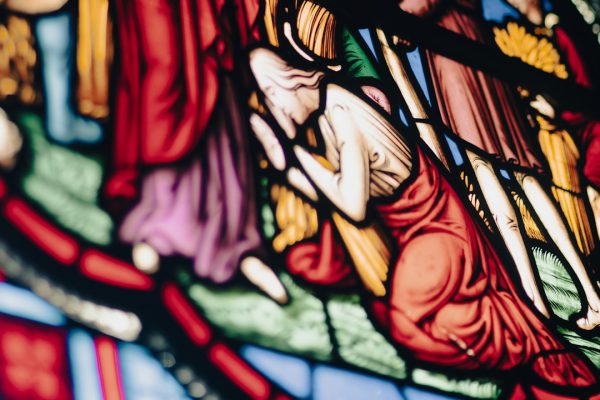This paper on the destruction of Jerusalem and the Vindication of Jesus was originally delivered to the Reformation Society of Western New York on February 8, 2024. For readablity, it has been converted into a series of articles. A PDF version is available.
Introduction
Part 1 | Judgment on God’s House: A Central Theme of the Prophets
Part 2 | The Final Verdict: Judgment for Israel and Vindication for the Son of Man
Part 3 | AD 70 as a Sign of “The End”
Concluding Implications
The purpose of this paper has been to argue that the destruction of Jerusalem and its temple in AD 70 is a theologically significant event in redemptive history that is foundational to New Testament eschatology. Even if only partially successful, this study has demonstrated how this event can be understood along with the resurrection, the outpouring of the Spirit, and the growth of the church as an eschatological sign that Christ has inaugurated his kingdom, that God’s plans and purposes of salvation for the world are now located in Christ and his church, and that Christ is even now putting his enemies under his feet. To conclude, I will briefly consider several implications of understanding AD 70 as significant for NT eschatology.
A Solution for Problematic Passages and Perplexing Prophecy
First, this can bring clarity to several difficult passages regarding the coming of the kingdom and the Son of Man. In addition to those already mentioned, another controversial passage is Matthew 10:23, where Jesus tells his disciples: “When they persecute you in one town, flee to the next, for truly, I say to you, you will not have gone through all the towns of Israel before the Son of Man comes.” If we admit the possibility that Jesus is referring to the fall of Jerusalem, we have the solution to the timing of the kingdom in these verses. In the case of Matthew 10:23 this seems highly likely, especially considering that this statement follows a prediction of persecution by Jesus that virtually describes the book of Acts (Matt. 10:16-20)!
Second, this can help us more accurately understand several prophetic passages in the OT. For example, in Isaiah 66 the prophet sees that Jerusalem would once again face the Lord’s judgment and vengeance for their rebellion (Isa. 66:6). But then, Isaiah describes Zion as a mother suddenly and miraculously giving birth to a son (lit., a male child, cf. Rev. 12:1-6) and many children in the hour of her judgment, before she goes into labor. Commenting on the fulfillment of this vision, Barry Webb writes: “There is profound prophetic insight here, for in the fullness of time the new age came to birth just as Isaiah predicted. Out of the Israel of the old covenant, judged and rejected by God, emerged the church of Jesus Christ. It was already ‘born’, as it were, before Jerusalem’s destruction; that was simply the severing of the umbilical cord.”1Webb, The Message of Isaiah, 248.
Another example of a thorny OT passage is Daniel’s vision of the seventy weeks (Dan. 9:24-27). This vision is about the future of Jerusalem, the end of exile, and the time required to put an end to sin, atone for iniquity, and establish everlasting righteousness (Dan. 9:24). It describes the coming of a prince and an anointed one who would be cut off, make a covenant with many, put an end to sacrifice and offering, and whose people would also destroy the city and sanctuary. Rather than understand this to be primarily about the work of an “antichrist” figure at the end of history (!), it seems better to see this about the work of Christ, which has recently been argued by Meredith Kline and Peter Gentry.2See Meredith G. Kline, God, Heaven and Har Magedon: A Covenantal Tale of Cosmos and Telos (Eugene, OR: Wipf & Stock Publishers, 2006), 146-54; Peter J. Gentry and Stephen J. Wellum, Kingdom through Covenant: A Biblical-Theological Understanding of the Covenants (Wheaton, IL: Crossway, 2012), 531-564. He is the Anointed One who is cut off, who makes a covenant, and puts an end to sacrifice through his vicarious death on the cross (Isa. 53; Matt 26:28; Mark 14:24; Luke 22:20; Heb. 8:6-13; 9:11-10:25). As for the destruction of city and sanctuary by the “people of the prince,” this refers to the destruction of Jerusalem by the Romans, whom God sovereignly used to accomplish his purposes of judgment, as he did before with Assyria, Babylon, and Persia. Understood this way, Daniel’s vision of the seventy weeks lines up remarkably with the kingdom-inaugurating life and ministry of Jesus and God’s judgment on the holy city.
A First-Century Framework for the Book of Revelation
If the destruction of Jerusalem is a theologically significant event that is foundational to the inaugurated eschatology of the NT, as I have sought to demonstrate, then I would argue that AD 70 and the events leading up to it would also be described in the book of Revelation. According to Richard Bauckham, Revelation is the culmination of biblical prophecy3Richard Bauckham, The Climax of Prophecy: Studies on the Book of Revelation (Edinburgh: T&T Clark, 1993); see also Bauckham, The Theology of the Book of Revelation, New Testament Theology (Cambridge: Cambridge University Press, 1993)., and Brian Tabb has also persuasively argued that it is the canonical capstone and climax of Christian Scripture.4Brian Tabb, All Things New: Revelation as Canonical Capstone, ed. D. A. Carson, vol. 48, New Studies in Biblical Theology (England; Downers Grove, IL: Apollos; InterVarsity Press, 2019). If John’s apocalypse is truly understood in this way, then the judgment on Jerusalem, which Jesus said fulfills the Scriptures (cf. Luke 21:22), would naturally be foundational to it.
I propose that a first-century framework for Revelation not only makes the most sense of the internal evidence but holds some promise for harmonizing the various interpretive approaches to the book.This approach understands the majority of John’s vision to be describing events which will soon take place, namely the fall of Jerusalem in AD 70, which is then followed by the millennium and second coming. But this apocalyptic vision, as Leithart notes, “discloses a pattern of events that will be nonidentically repeated until the final judgment.”5Leithart, Revelation, vol. 2, 198.
Of course, one of the biggest hurdles in accepting that Revelation is remotely concerned with Jerusalem is the debate regarding the dating of the book. However, an early date is not essential for adopting a first-century framework for the majority of John’s vision. Even if John wrote after Jerusalem fell, he could still be showing the theological significance of AD 70 and offering an interpretation of current events in light of that event. Sam Storms, who holds to a late date for Revelation, understands the significance of AD 70 for the book in a similar way:
The pattern of events that transpired in the period 33-70 a.d., leading up to and including the destruction of Jerusalem and its temple, functions as a local, microcosmic foreshadowing of the global, macrocosmic events associated with the Parousia and the end of history. The period 33-70 a.d. provides in its principles (though not necessarily in all particularities), a template against which we are to interpret the period 70-Parousia.6Sam Storms, “The Revelation of Jesus Christ, the Ruler of Kings on Earth – Revelation 1:8,” https://www.samstorms.org/all-articles/post/the-revelation-of-jesus-christ-the-ruler-of-kings-on-earth. This is how Storms also understands the Olive Discourse. See Storms, “Matthew 24 and the Olivet Discourse – Part III,” https://www.samstorms.org/all-articles/post/matthew-24-and-the-olivet-discourse—part-iii.
A detailed defense of an early date is not within the scope of this paper. However, a few salient strands of evidence are worth mentioning that will hopefully provide motivation for a reevaluation of the internal evidence for a first-century framework.
First, it is an established fact that Revelation echoes or alludes to nearly every book of the OT. The prophetic messages against all the nations, but especially Jerusalem, are repeated throughout John’s vision. For example, when the sixth seal is opened, apocalyptic language is used to describe what appears to be the end of the world, which we know is used to also describe nations being judged in history (Rev. 6:12-14; Isa. 13; Ezek. 32). When this happens, the people begin “calling to the mountains and rocks, ‘Fall on us and hide us” (Rev. 6:16). While this surely describes the response of all those who will face the great day of the wrath of the Lamb, whenever it comes, this is the exact verse from Hosea 10:8 that Jesus quotes on his way to the cross to describe what Israel will say when it faces judgment for rejecting him (Luke 23:30).
Second, while many commentators are quick to identify the “great city” with Rome, there are many reasons to identify this city as first being Jerusalem. For example, when we first meet the “great city,” we learn that it is symbolically (or “spiritually,” πνευματικῶς) called Sodom and Egypt, which is how Israel was described in the prophets (Isa. 1:10; Ezek, 23). More importantly, we learn it is also the city where the Lord was crucified. If that is not clear enough, the next time we meet this city, it is called the harlot city Babylon (Rev. 16-18). This “great prostitute,” is arrayed in the colors and jewels of the priests and tabernacle, who is “drunk with the blood of the saints, the blood of the martyrs of Jesus” (Rev. 17:1-6). Many scholars identify this as a picture of the goddess Roma. But in the OT, which is the pallet John uses to paint his apocalypse,7Leithart, Revelation, vol. 1, 5. the most famous harlot was Israel (Ezek. 16; 23). Leithart reminds us that, “In the biblical perspective, only a people or a city in covenant with Yahweh can be guilty of harlotry.”8Leithart, Revelation, vol. 2, 172. Interestingly, the only other two cities called harlots are Nineveh (Nah. 3:4) and Tyre (Isa.23:15-17). While these cities were not directly in covenant with Yahweh, like Israel, Leithart observes that Nineveh was a repentant city that became apostate, and Tyre initially helped built the Temple by providing supplies. But Jezebel, the daughter of the king of Tyre and Sidon (1 Kgs. 16:31), married Ahab, who helped build a house for Baal in Israel. “Like Nineveh, Tyre is an apostate Gentile city, not a pagan one.” Ibid., 173. Based on the OT, the harlot is Jerusalem, who rides the back of the Roman beast (cf. Luke 23:12). If the woman is Jerusalem and the beast is Rome, this would explain why John sees the beast turning on the woman to “make her desolate” and “burn her up with fire” (Rev. 17:16-17).
The most compelling evidence for identifying the harlot Babylon as Jerusalem is found in chapter 18. Here we discover not only that this is the city where the Lord was crucified, but in this city “was found the blood of prophets and of saints, and of all who have been slain on earth” (Rev. 18:24). This is a remarkably close parallel to what Jesus said about Jerusalem in his woes:
Fill up, then, the measure of your fathers. You serpents, you brood of vipers, how are you to escape being sentenced to hell? Therefore I send you prophets and wise men and scribes, some of whom you will kill and crucify, and some you will flog in your synagogues and persecute from town to town, so that on you may come all the righteous blood shed on earth, from the blood of righteous Abel to the blood of Zechariah the son of Barachiah, whom you murdered between the sanctuary and the altar. (Matt. 23:32-35).
If John is alluding to Jesus’ statement, it is highly likely that Jerusalem is the city in view. Furthermore, if Jerusalem is the harlot Babylon, then the contrasting vision of the New Jerusalem as the Bride of the Lamb becomes all the more compelling. Smalley writes: “If Jerusalem were about to be destroyed, the vision in Rev. 21–22 of a stunning and emphatically new holy city, where God’s people will dwell eternally in a close covenant relationship with him, would have provided exactly, and at the right moment, all the spiritual encouragement they needed.”9Stephen S. Smalley, The Revelation to John: A Commentary on the Greek Text of the Apocalypse (London: SPCK, 2005), 3
This brief look at a first-century framework for Revelation barely scratches the surface, and may have only muddied the waters. The point, however, is that if we take Revelation seriously as the canonical capstone of Scripture and the climax of biblical prophecy, then we should reconsider the role that Jerusalem plays in the final book of the canon that “brings the scriptural narrative concerning God, his people and his world to its grand conclusion in the already-not-yet reign of Christ and the glorious new creation.”10Tabb, All Things New, 24.
Ultimately, my aim has been to provide a more robust understanding of the profound impact that Jesus had on the role of Jerusalem and its temple in redemptive history. If the Bible is all about Jesus, and if the eschatological hopes of Israel have begun to be fulfilled in the advent of Israel’s Messiah, then the theological significance of Jerusalem and its temple must be re-evaluated in light of his kingdom-inaugurating life and ministry.

Mitch Bedzyk serves as a pastor Emmanuel Community Church, overseeing music and Sunday Classes. He received his Master of Theological Studies from Midwestern Baptist Theological Seminary and works in IT for the NY Office of Mental Health. He and his wife, Sarah, have five children: Kya, Khalli, Oliver, Amelia, and Micah. In his spare time he enjoys reading, coffee, guitar, being an MLS fanatic and playing fantasy soccer.




